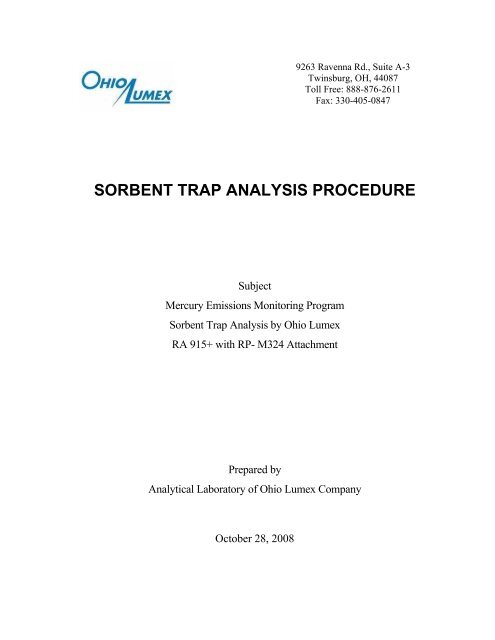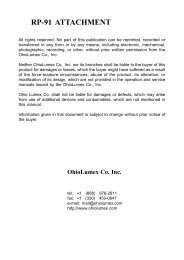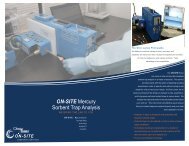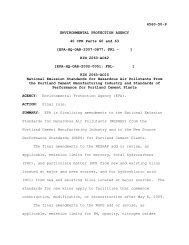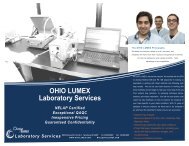SORBENT TRAP ANALYSIS PROCEDURE - Ohio Lumex Co.
SORBENT TRAP ANALYSIS PROCEDURE - Ohio Lumex Co.
SORBENT TRAP ANALYSIS PROCEDURE - Ohio Lumex Co.
- No tags were found...
You also want an ePaper? Increase the reach of your titles
YUMPU automatically turns print PDFs into web optimized ePapers that Google loves.
9263 Ravenna Rd., Suite A-3Twinsburg, OH, 44087Toll Free: 888-876-2611Fax: 330-405-0847<strong>SORBENT</strong> <strong>TRAP</strong> <strong>ANALYSIS</strong> <strong>PROCEDURE</strong>SubjectMercury Emissions Monitoring ProgramSorbent Trap Analysis by <strong>Ohio</strong> <strong>Lumex</strong>RA 915+ with RP- M324 AttachmentPrepared byAnalytical Laboratory of <strong>Ohio</strong> <strong>Lumex</strong> <strong>Co</strong>mpanyOctober 28, 2008
CONTENTS------------------------------------------------------------------------------------------------------------------1 INTRODUCTION TO THE <strong>ANALYSIS</strong> METHOD WITH RA-915+MERCURY ANALYZER32 ANALYTICAL METHOD DETAILS 42.1 Instrument Start-up 42.2 Preliminary Determination of Mercury Mass 52.3 Analyzer Calibration 62.3.1 Calibration procedure 62.3.2 Calibration criteria 92.4 Preparation of Sorbent Traps for Testing 92.5 Calibration Verification and Postcalibration 112.5.1 Analysis of continuing calibration verification standard 112.5.2 Postcalibration 122.6 Data Saving and Reporting 123 DEFINITIONS 124 HEALTH AND SAFETY 135 REFERENCES 132
1 INTRODUCTION TO THE <strong>ANALYSIS</strong> METHOD WITH RA-915+ MERCURYANALYZERThis document describes the analytical procedure of sorbent traps using the <strong>Ohio</strong><strong>Lumex</strong> RA915 + with RP-M324 furnace and pump module for total mercury (Hg) analysisby thermal decomposition with atomic absorption.The analytical method at <strong>Ohio</strong> <strong>Lumex</strong> is based on thermal desorption per EPA Method 7473(direct thermal desorption with atomic absorption and no gold amalgamation). The method isapplicable for total mercury “direct” testing of 40 CFR Part 75 Appendix K and EPA Method30B sorbent traps. The reporting limit (RL) is equal to the method detect limitation (MDL)determined for the instrument for total mercury.Atomic Absorption technology is used for no sample preparation analysis. No liquidchemicals, or gases required, no chemical waste is generated. Analysis time is about 90seconds per sample under profile 1 and 2 condition and 350 seconds in Profile 3.Analytical Range: Profile 1; 1- 5,000ng, Profile 3: 10-30,000ng, Profile 4: 10-100,000ng.The required instrument and accessories for performing the analysis include,- <strong>Ohio</strong> <strong>Lumex</strong>- RA 915+ with RP-M 324 Attachment, exhaust pump module and<strong>Co</strong>mputer;- <strong>Ohio</strong> <strong>Lumex</strong> 6 inch ladles;- Assorted laboratory equipment, which includes spatulas, dissecting forceps,stainless steel seeker probe, adjustable pipettes, aluminum weigh boats, aluminumfoil, etc.Reagents and standards include,- NIST-certified and traceable mercury calibration standardsTwo separate sets of standards are required for calibration and independentcalibration verification standards;Although the Zeeman correction used by the <strong>Ohio</strong> <strong>Lumex</strong> analyzer eliminates spectralinterferences the choice of sorbent media is important. Wrong sorbent media will not satisfyQA/QC method requirements and also could degrade the optical furnace elements in thecombustion chamber. Sodium carbonate is placed on top of the carbon media to capture theacid gases.3
2. ANALYTICAL METHOD DETAILSThe sorbent trap tube end cap is removed; the glass wool plug closest to the appropriatecarbon bed is carefully removed and separated from the carbon fraction. The sorbent istransferred into a quartz ladle and then covered with anhydrous sodium carbonate. The ladleis inserted into the heated analyzer thermo catalytic conversion chamber. As a result,mercury is converted from a bound state to the atomic state by thermal decomposition in thefurnace and is then detected by atomic absorption with Zeeman correction. The mercuryconcentration is measured and recorded using an automated data acquisition system. Boththe glass wool plug and the sorbent of each bed are analyzed for the trap and the finalmercury mass is the sum of the measurements.The procedure for the trap analysis is described here step by step,a. Instrument start-upb. Preliminary determination of mercury mass in the traps,c. Analyzer calibration,d. Trap analysis,e. Verification of calibration during testing and postcalibration,f. Data saving and results reporting.2.1 Instrument Start-up2.1.1 Set up the connections among RA-915+ analyzer, RP-M324 attachment, mercuryfilter and laptop computer.2.1.2 <strong>Co</strong>nnect power cord to RA-915+, RP-M324 and laptop computer.2.1.3 <strong>Co</strong>mplete setup with heat shield.2.1.4 Turn on computer.2.1.5 Turn on RA-915+ power toggle switch and ignite mercury lamp by pressing andholding lamp ignition button for 3 seconds.2.1.6 Turn on the RP-M234 power supply. Adjust the carrier pump flow to be adesired one. Flow rate 2 liters/min is for profile 1, 4.5 liters/min for profile 2 and3. Please note the EZ zone controller does automatic flow selection based onprofile number. For SD series controllers Flow setting is manual and usuallysame for Prof 1 and 2 and equal to 4 LPM.2.1.7 Start the RA-915 software from the Windows main screen by double click theicon . The RA-915+ Main menu screen will appear.2.1.8 Select “<strong>Co</strong>mplex” on RA-915+’s main menu screen, a table window (“Table.<strong>Co</strong>mplex analysis”) and a graph window (“<strong>Co</strong>mplex Sample analysis Graph”)4
ecome activ. Click on the window headers to alternate between the twoscreens.2.1.9 Click the “run” icon from graph window to see the running signals.2.1.10 Enter information in table window, Name and Save folder in My Documents.2.1.11 Allow the system to be heated at 680/650C for at least 60 minutes beforecalibration.2.1.12 Click the icon to view the average baseline value and the baseline RSD.After 20 mins system running, if the RSD is larger than 5, shut off the furnaceand clean the detector windows (see Reference 1 for maintenance).2.1.13 Click the icon (baseline check) and allow the baseline to adjust for 10seconds. After 10 seconds click on again, to turn off the baselineadjustment and complete the baseline correction. Repeat this step until theaverage baseline is near zero and the RSD is less than 4. After the initial start-upof the instrument, baseline drift will be maximum and minimized with heating.2.2 Preliminary Determination of Mercury MassThe expected mercury mass is an estimate of the total mercury collected in section 1 of asorbent trap. The determination for this amount is very important to decide the calibrationrange and what profile should be used to perform the analysis.Knowledge of estimated stack mercury concentrations and total sample volume may berequired prior to analysis. Information may be received from the stack testers. However, ananalyst should always evaluate the traps based on the information shown in the “Chain ofCustody”. Sampling duration, flow rate, dust temperature, meter temperature and dry gasvolume are necessary for the evaluation. A proper testing profile can be chosen after trapevaluation.Table 1 and Table 2 show the most current, up to date profiles used in the <strong>Ohio</strong> <strong>Lumex</strong> RA-915+ with M324 attachment, EZ-Zone controller or SD controller.Table 1. Profiles and Applications (EZ-Zone <strong>Co</strong>ntroller)Profiles Flow Rate Test Range Test Time Trap Performance(L/min) (ng)(second)1 2 1-2,000 100 Not Ramping 0.5-2 hours sampling(RATA)2 4.5 10-10,000 150 Not Ramping Up to 5 days sampling (wet5
2.3.1 Calibration procedure1) In the “Table. <strong>Co</strong>mplex sample analysis” window enter the appropriate testingdescription information (For example, sample type, analysis date, etc) into the topbox just below the menu icons on the table window. Save folder.2) Check the RSD and average baseline. The baseline can be slightly positive ornegative. The current value window is helpful when monitoring the baseline. Adjustthe baseline for 10 seconds if necessary. At a static state, RSD should be a stablevalue.3) BLANK: Place cursor in description column (second column) beside No 1. Doubleclick left mouse and select BLANK. Using the tab button on the keyboard tab to themass column (third column) labeled “M, mg”, enter number 1 into the box, then tabover to the concentration column labeled “C, ng/g”.4) Switch back (by clicking on it) to the “<strong>Co</strong>mplex analysis graph” to view the analysis.5) Place some calibration sorbent into ladle, (about 0.7 gram sorbent is needed whenApppendix K traps are going to be tested, or 0.3g sorbent when Method 30B traps aregoing to be tested). <strong>Co</strong>ver the sorbent with anhydrous sodium carbonate. Gently packthe sorbent and carbonate in the ladle by covering the opening with a small piece ofaluminum foil and compressing the solids through the foil with finger palms.Carbonate must completely cover the sorbent. Remove the aluminum foil from theladle before analysis.6) Click START on the integration window. Immediately insert the prepared ladleloaded with sorbent and sodium carbonate into the furnace.7) Allow the Blank to run for 90 seconds as measured by the elapsed time.8) Click END on integration window to stop the analysis. Remove the ladle from thefurnace; dispose the containing into a heat-resistant (metal) tray, put ladle on a heatresistantsurface to allow it cool before loading it again. The integration area andmaximum peak height will be displayed in the “Integration” window. These valueswill also be automatically entered into the appropriate columns in the Table.9) CALIBRATION; Switch to the “Table. <strong>Co</strong>mplex analysis” window. Place thecursor in the description column (second column) beside No 2. Double click leftmouse and select STD_. Type in the standard Hg mass (in ng) after the dualunderscore, for example STD__10. Check the mass column (M, mg), number 1should be always there. Tab the curser to the concentration column (C, ng/g).10) Switch back to the “<strong>Co</strong>mplex analysis graph” (click on it) to view the analysis.11) Load the ladle as in Step 5 above. Pipette the desired volume of the appropriatestandard onto the sorbent (For example, 10 µl of 10 µg/ml standard equals 100 ngmercury, enter 100 after STD__100).7
A calibration graph will appear and the new calibration coefficient will be listed as A.Click on the apply icon then click on the EXIT icon, . A window will pop-upand ask you to save the calibration coefficients. Click YES.19) While the standards are still highlighted in the “Table <strong>Co</strong>mplex analysis window”Click on the CALCULATE icon, , under the Table heading. The program willfill in the calculated values of the standards based on the current calibration curve.The current calibration coefficient (A) and the Y intercept ( <strong>Co</strong>) will be found at theupper right hand corner of the “Table <strong>Co</strong>mplex analysis window” .20) If any of the calibration points are unacceptable they can be rerun using the methodabove. When creating the calibration curve and determining the calibrationcoefficient only highlight the desired standards by holding the Ctrl and selecting(highlighting) acceptable calibration lines with left mouse button.Another option to evaluate the calibration is to use <strong>Ohio</strong> <strong>Lumex</strong> <strong>Co</strong>mpany calibrationsoftware, ‘minical915’. In this software, entering the corresponding area countnumber for each tested standard, a calibration curve, calibration coefficient, R 2 ,standard deviation, % RSD and recovery percentage will display automatically. Thesoftware is distributed upon customer’s request.21) Save the data in the Table <strong>Co</strong>mplex analysis by clicking on the SAVE icon, ,under the File header or use “Save as” in the file pull-down menu. Create a folder forsaving the data, do not save files in the RA915P directory.22) The upgrade from standard 3.17.4 is 3.20.4 <strong>Lumex</strong> RA-915+ software is able toshow a linear correlation coefficient (R 2 ) from calibration window. However, toperform a linear regression analysis and determine the R 2 from version 3.17.4 of<strong>Lumex</strong> software, first the current <strong>Co</strong>mplex sample analysis table needs to be savedand then exported to Microsoft EXCEL. (Click on the EXCEL EXPORT icon,, under the File header. A “Save as” window will open which says “Excelformat files as *.xls in the “Save as type” box. Type in a file name and click onSAVE.) Reopen the saved Excel file in Excel. Plot the Area values against thestandard concentration using a XY scatter plot. Add a linear trend line to the plot. Inthe “Add Trend Line” window click on the “Linear” line type. Then select theOPTIONS tab and check the “Set intercept box” and type in the y intercept valuefrom the top right corner of the “Table <strong>Co</strong>mplex analysis window” from the RA915Psoftware. Also check on the “Display equation on chart” and the “Display R-squaredvalue” on chart. The equation of the line will be shown on the chart. The slope of theline should match the calibration coefficient found in the top right corner of the9
“Table <strong>Co</strong>mplex analysis window” from the RA915P software. The R-squared valuedisplaced on the Excel graph is the correlation coefficient for the calibration.2.3.2 Calibration criteriaA multipoint calibration is required. Three or more standards should be used to make acalibration curve. An independent standard, for example a NIST solid standard or an <strong>Ohio</strong><strong>Lumex</strong> NIST traceable mercury standards from a separate lot, will be analyzed to ensure theaccuracy of the calibration. The lowest point in the calibration curve must be at least 5, andpreferably 10 times the MDL.The calibration criteria is,1) Calibrations must be performed on the day of the analysis, before analyzing any ofthe samples;2) Three or more calibration points must be used;3) The field samples analyzed must fall within a calibrated, quantitative range and meetthe performance criteria of method 30B or Appendix K;4) For each calibration curve, r 2 ≥ 0.99, and the analyzer response must be within ± 10%for each standard used in the calibration;5) Following calibration, a second source standard is analyzed. The measured value ofthe independently prepared standard must be within ± 10% of the expected value;6) The analysis of blanks is needed.The Hg amount in each spiked or sample section must fall into the calibrated range of theanalyzer, and the mercury amount in sample section must fall within the lower and uppermass limits established during the initial Hg 0 and HgCl 2 analytical bias test. For extra lowlevelsamples (Hg mass is below the lowest point in the calibration curve and above theMDL), a response factor (e.g. area count per Hg mass) is established based on a singlestandard at level > MDL and less than the lowest point in the calibration. Amount of Hgpresent is calculated based on this response factor.2.4 Preparation of Sorbent Traps and TestingThe sorbent trap tube end cap is removed; the glass wool plug preceding to the appropriatecarbon bed is carefully removed and separated from the carbon section. The sorbent istransferred into a quartz ladle, and then covered with anhydrous sodium carbonate and theladle is inserted into the analyzer thermo catalytic conversion chamber. The plug will betightly wrapped into aluminum foil. For bias test traps, 30 B traps and <strong>Ohio</strong> <strong>Lumex</strong> Type-IIAppendix K traps (0.7 gram sorbent in each section), the plug is tested together with the10
sorbent in one ladle. For <strong>Ohio</strong> <strong>Lumex</strong> Type-I Appendix K and other traps, which have 1.0gram sorbent in each section, the plug is tested separately (this trap is no longer made).Figure 1 is an illustration of an Appendix K trap. According to the flow direction, eachsorbent section is named as S1, S2 and S3. The plug is named P1, P2, P3 and P4. Themercury mass in each section is written as s1, s2 and s3, as well as the plugs, p1, p2, p3 andp4. The testing chart of an Appendix K trap is illustrated in Figure 2.FlowS1 S2 S3P1 P2 P3 P4Figure 1. Illustration of an Appendix K trapFigure 2. Testing procedure of a type I- Appendix K trap11
FlowS1S2P1 P2 P3Figure 3. Illustration of a 30B trapFigure 4. Testing Procedure of a 30B trapFigure 2 and Figure 4 indicate how to determine mercury mass in each section of the trap.Some traps come with <strong>Ohio</strong> <strong>Lumex</strong> prefilter. The prefilter should be tested with P1 together(unless customer wants to report it separately), and the mercury mass in section 1 would bethe sum of p1, s1 and the mercury in prefilter.The procedure for testing other traps is similar, such as for the 6 mm traps, speciation traps,and Appendix K-RATA traps. For a single-section bias trap, the mercury mass is the sum ofp1, p2 and s1.a TIP for analysis traps,In order to cut down the analysis time, fast profiles are strongly recommended to use, whichare profile 1 and 2 for the EZ-Zone controller, or profile 1 for the SD controller. If theexpected Hg amount in the testing sample is higher than the profile testing range, but not tomuch higher, mix well the sorbent from trap, split it in half and analyze with plug in the sameladle using fast profile.12
2.5 Calibration Verification and Postcalibration2.5.1 Analysis of continuing calibration verification standard (CCVS).After no more than 10 analyses, a continuing calibration-verification standard must beanalyzed. The measured value of the continuing calibration standard must be within ±10% ofthe expected value. Repeat to get into +-10% and recalibrate if required.2.5.2 PostcalibrationAt the end of each set of analysis, a calibration standard will be tested. The value of thisstandard must be with ±10% of the expected value.2.6 Data Saving and ReportingAt the end of testing, all data should be saved in the <strong>Ohio</strong> <strong>Lumex</strong> database. Data can bereported as an Excel file, (*.xls), or as a report format (*.qrp). Customer can request anextended testing report and the related certificates of instrument as well as standards from<strong>Ohio</strong> <strong>Lumex</strong> Analytical Libratory.An extended report includes the following,- Analyzer certificate;- Standards certificates;- A formal report, which shows all calibration data, and trap testing result;- A graph printout to show testing process;- Precalibration graph;- Postcalibration graph;3. DEFINITIONSHg –Hg 0Hg 2+HgCl 2HClSorbent –MercuryElemental MercuryOxidized MercuryMercury ChlorideHydrochloric AcidMedia used in traps to adsorb mercury. May be halogenated or nonhalogenatedcarbon.13
Trap –Method 30BAppendix KBlank-CalibrationStandards-Independentstandards-MDL-Glass tube packed with one, two or three beds of carbon sorbent heldin place and separated by glass wool. The sample trap is placed in thesampling probe and flue gas is pulled through the sample trap. Thecarbon in the trap adsorbs mercury which is then used to determine themercury concentration in the flue gas.a procedure, published by US EPA, for measuring total vapor phasemercury emissions from coal-fired combustion source using sorbenttrap sampling and an extractive or thermal analytical technique.quality assurance and operating procedures, published by US EPA, forsorbent trap monitoring systemsAny raw carbon sample not spiked with liquid mercury solution orelemental mercury gas.NIST certified or traceable mercury standards used to determine aninstrument calibration.NIST traceable or certified mercury standards from separate lot ormanufactures than the calibration standards.Method detection limit, the minimum concentration of mercury thatcan be analyzed, measured and reported within 99 % confidence thatthe concentration is greater than zero.4. HEALTH AND SAFETYProper protective equipment (safety glasses, nitrile gloves) shall be worn while performinganalysis. Use of acid and mercury exhaust scrubbers supplied with analyzer minimizes therisk of operator mercury exposure and as tested were much below OSHA-100ug/m3 andACGIH-25ug/m3 established TLV. We recommend to change scrubbers as a set once peryear.We recommend periodically once per month test the scrubbers exhaust by a sorbent trapMethod 30B or with <strong>Lumex</strong> direct intake nozzle switching to Hg in ambient air mode—referto RA 915+ user manual.5. REFERENCES1) “Thermal analysis for field sorbent trap mercury testing (formal method 324)”,instruction hand book, <strong>Ohio</strong> <strong>Lumex</strong> <strong>Co</strong>mpany Inc., 200614
2) Method 7473- “ Mercury in solids and solutions by thermal decomposition,amalgamation, and atomic absorption spectrophotometry” , US EPA, 2007www.epa.gov/sw-846/pdfs/7473.pdf .3) Method 30B-“Determination of total vapor phase mercury emissions from coal-firedcombustion sources using carbon sorbent traps”, US EPA, 2007http://www.epa.gov/ttn/emc/promgate/Meth30B.pdf4) Appendix K to Part 75-“Quality assurance and operating procedures for sorbent trapmonitoring system”, US EPA, 200515


